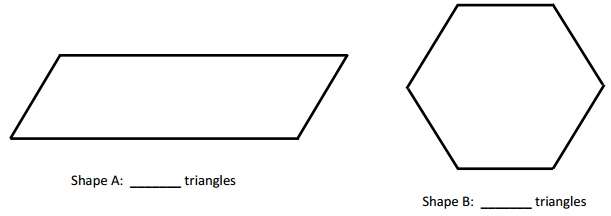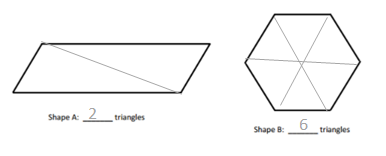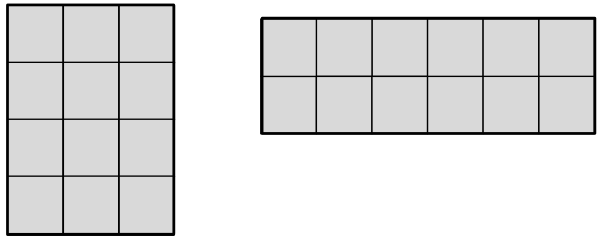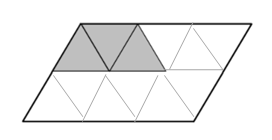Grade 3 Eureka Math Answer Key is provided by subject experts as per the Common Core curriculum. Grade 3 Eureka Math Solutions provided educates the primary school Kids on all Math concepts of the chapter efficiently. Eureka Math Grade 3 Textbook Answers makes it easy for kids to Grasp the Concepts as well as solve any problem from chapter Tests, Practice Tests, Performance tests, cumulative practice, etc.
Engage NY Eureka Math 3rd Grade Module 4 Lesson 1 Answer Key
Eureka Grade 3 ensures students with the learning targets and success criteria. The Diverse opportunities will develop problem-solving skills among the primary school kids practicing Bigideas Math Grade 3 Solutions. Eureka Textbook Grade 3 answers help Students Master the subject on Consistent practice.
Eureka Math Grade 3 Module 4 Lesson 1 Problem Set Answer Key
Question 1.
Use triangle pattern blocks to cover each shape below. Draw lines to show where the triangles meet. Then, write how many triangle pattern blocks it takes to cover each shape.

Answer:
The number of triangles in shape A =4
the number of triangles in shape B= 6.
Explanation:
In the above-given question,
given that,
In the parallelogram, there are 4 triangles.
in the hexagon, there are 6 triangles.
so the number of triangles in shape A = 4.
so the number of triangles in shape B= 6.

Question 2.
Use rhombus pattern blocks to cover each shape below. Draw lines to show where the rhombuses meet. Then, write how many rhombus pattern blocks it takes to cover each shape

Answer:
The number of rhombuses in shape A = 2.
the number of rhombuses in shape B= 3.
Explanation:
In the above-given question,
given that,
In the parallelogram, there are 2 rhombuses.
in the hexagon, there are 3 rhombuses.
so the number of rhombuses in shape A = 2.
so the number of rhombuses in shape B= 6.

Question 3.
Use trapezoid pattern blocks to cover each shape below. Draw lines to show where the trapezoids meet. Then, write how many trapezoid pattern blocks it requires to cover each shape.

Answer:
The number of trapezoids in shape A = 2.
the number of trapezoids in shape B= 2.
Explanation:
In the above-given question,
given that,
In the parallelogram, there is 2 trapezoid.
in the hexagon, there are 2 trapezoids.
so the number of trapezoids in shape A = 2.
so the number of trapezoids in shape B= 2.

Question 4.
How is the number of pattern blocks needed to cover the same shape related to the size of the pattern blocks?
Answer:
The number of square pattern blocks used to cover the rectangle = 40.
Explanation,
In the above-given question,
given that,
the number of rows in rectangle = 5.
the number of columns in rectangle = 8.
5 x 8 = 40.

Question 5.
Use square pattern blocks to cover the rectangle below. Draw lines to show where the squares meet. Then, write how many square pattern blocks it requires to cover the rectangle.

___40_____ squares
Answer:
The number of square pattern blocks used to cover the rectangle = 40.
Explanation,
In the above-given question,
given that,
the number of rows in rectangle = 5.
the number of columns in rectangle = 8.
5 x 8 = 40.

Question 6.
Use trapezoid pattern blocks to cover the rectangle in Problem 5. Can you use trapezoid pattern blocks to measure the area of this rectangle? Explain your answer.
Answer:
The number of trapezoid pattern blocks used to cover the rectangle = 4.
Explanation,
In the above-given question,
given that,
the number of rows in rectangle = 2.
the number of columns in rectangle = 2.
2 x 2 = 4.

Eureka Math Grade 3 Module 4 Lesson 1 Exit Ticket Answer Key
Each  is 1 square unit. Do both rectangles have the same area? Explain how you know.
is 1 square unit. Do both rectangles have the same area? Explain how you know.

Answer:
Yes, both have the same area = 12.
Explanation,
In the above-given question,
given that,
the number of rows in rectangle = 4.
the number of columns in rectangle = 3.
4 x 3 = 12.
the number of rows in rectangle = 2.
the number of columns in rectangle = 6.
2 x 6 = 12.
so both have the same area = 12.
Eureka Math Grade 3 Module 4 Lesson 1 Homework Answer Key
Question 1.
Magnus covers the same shape with triangles, rhombuses, and trapezoids.
a. How many triangles will it take to cover the shape?

____12___ triangles
Answer:
The number of triangles will it take to cover the shape = 12.
Explanation,
In the above-given question,
given that,
the number of rows in parallelogram = 2.
the number of columns in parallelogram = 6.
2 x 6 = 12.
so the number of triangles will it take to cover the shape = 12 triangles.

b. How many rhombuses will it take to cover the shape?

____6___ rhombuses
Answer:
The number of rhombuses will it take to cover the shape = 6.
Explanation,
In the above-given question,
given that,
the number of rows in parallelogram = 2.
the number of columns in parallelogram = 3.
2 x 3 = 6.
so the number of rhombuses will it take to cover the shape = 6.

c. Magnus notices that 3 triangles from Part (a) cover 1 trapezoid. How many trapezoids will you need to cover the shape below? Explain your answer.

___4____ trapezoids
Answer:
The number of trapezoids will it take to cover the shape = 4.
Explanation,
In the above-given question,
given that,
the number of rows in parallelogram = 2.
the number of columns in parallelogram = 2.
2 x 2 = 14.
so the number of trapezoids will it take to cover the shape = 4 trapezoids.

Question 2.
Angela uses squares to find the area of a rectangle. Her work is shown below.
a. How many squares did she use to cover the rectangle?

____12___ squares
Answer:
The number of squares to find the rectangle = 12.
Explanation,
In the above-given question,
given that,
the number of rows in rectangle = 4.
the number of columns in rectangle = 3.
4 x 3 = 12.
so the number of squares = 12.
b. What is the area of the rectangle in square units? Explain how you found your answer.
Answer:
The number of squares to find the rectangle = 12.
Explanation,
In the above-given question,
given that,
the number of rows in rectangle = 4.
the number of columns in rectangle = 3.
4 x 3 = 12.
so the number of squares = 12.
Question 3.
Each ![]() is 1 square unit. Which rectangle has the largest area? How do you know?
is 1 square unit. Which rectangle has the largest area? How do you know?

Answer:
Rectangle A has the largest area.
Explanation:
In the above-given question,
given that,
the number of rows in rectangle A = 3.
the number of columns in rectangle A = 6.
3 x 6 = 18.
the number of rows in rectangle B = 4.
the number of rows in rectangle B = 2.
4 x 2 = 8.
the number of rows in rectangle C = 10.
the number of rows in rectangle C = 0.
10.
so rectangle A has the largest area.